Marketing Practices: Tangible Evidence Comparison: Hotels
VerifiedAdded on 2020/04/07
|9
|2372
|107
Report
AI Summary
This report examines the marketing practices of Hilton and Marriott hotels, with a specific focus on the creation of tangible evidence to enhance service delivery. The study begins by defining service delivery and the importance of physical evidence, then introduces the two hotel companies. The core of the analysis involves a comparison of their websites, assessing how each firm utilizes elements like logos, pictures, and detailed information to convince customers of their service quality. The analysis concludes that both hotels effectively create tangible evidence online, but Hilton's website is deemed more visually appealing and effective. The report highlights how tangible cues are crucial in the hospitality industry, where services are intangible, and how these cues build trust and influence customer perceptions. The study references various marketing and hospitality management sources to support its claims.
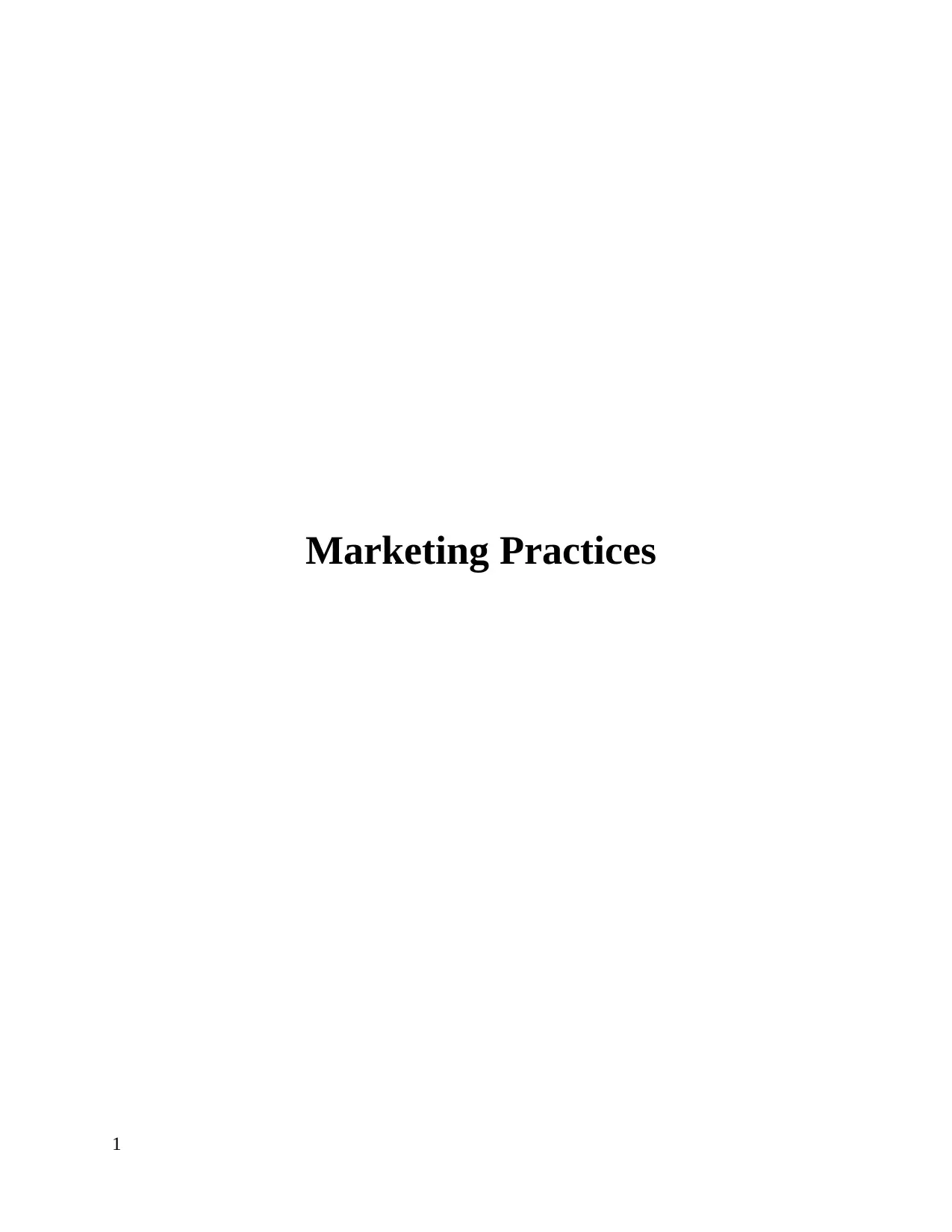
Marketing Practices
1
1
Paraphrase This Document
Need a fresh take? Get an instant paraphrase of this document with our AI Paraphraser
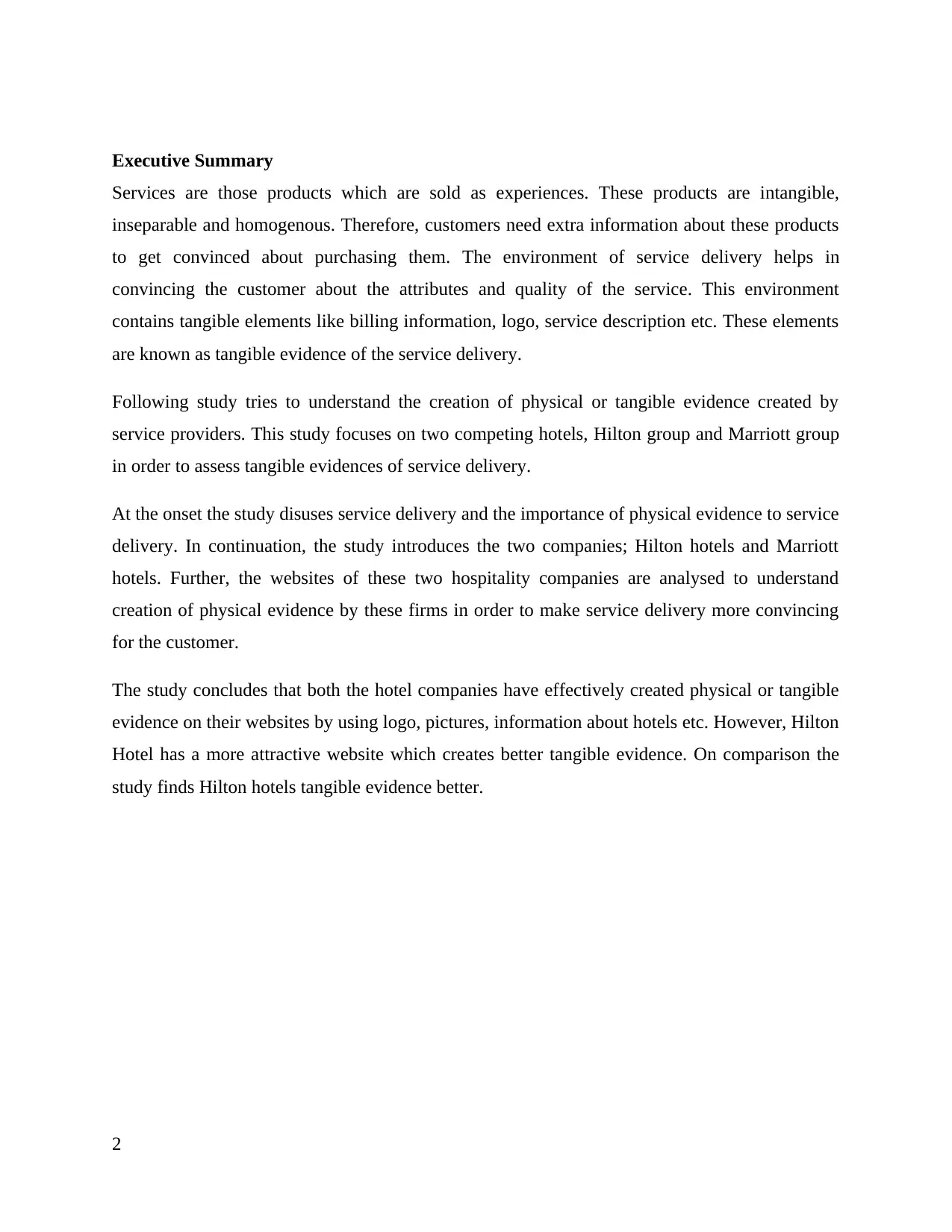
Executive Summary
Services are those products which are sold as experiences. These products are intangible,
inseparable and homogenous. Therefore, customers need extra information about these products
to get convinced about purchasing them. The environment of service delivery helps in
convincing the customer about the attributes and quality of the service. This environment
contains tangible elements like billing information, logo, service description etc. These elements
are known as tangible evidence of the service delivery.
Following study tries to understand the creation of physical or tangible evidence created by
service providers. This study focuses on two competing hotels, Hilton group and Marriott group
in order to assess tangible evidences of service delivery.
At the onset the study disuses service delivery and the importance of physical evidence to service
delivery. In continuation, the study introduces the two companies; Hilton hotels and Marriott
hotels. Further, the websites of these two hospitality companies are analysed to understand
creation of physical evidence by these firms in order to make service delivery more convincing
for the customer.
The study concludes that both the hotel companies have effectively created physical or tangible
evidence on their websites by using logo, pictures, information about hotels etc. However, Hilton
Hotel has a more attractive website which creates better tangible evidence. On comparison the
study finds Hilton hotels tangible evidence better.
2
Services are those products which are sold as experiences. These products are intangible,
inseparable and homogenous. Therefore, customers need extra information about these products
to get convinced about purchasing them. The environment of service delivery helps in
convincing the customer about the attributes and quality of the service. This environment
contains tangible elements like billing information, logo, service description etc. These elements
are known as tangible evidence of the service delivery.
Following study tries to understand the creation of physical or tangible evidence created by
service providers. This study focuses on two competing hotels, Hilton group and Marriott group
in order to assess tangible evidences of service delivery.
At the onset the study disuses service delivery and the importance of physical evidence to service
delivery. In continuation, the study introduces the two companies; Hilton hotels and Marriott
hotels. Further, the websites of these two hospitality companies are analysed to understand
creation of physical evidence by these firms in order to make service delivery more convincing
for the customer.
The study concludes that both the hotel companies have effectively created physical or tangible
evidence on their websites by using logo, pictures, information about hotels etc. However, Hilton
Hotel has a more attractive website which creates better tangible evidence. On comparison the
study finds Hilton hotels tangible evidence better.
2
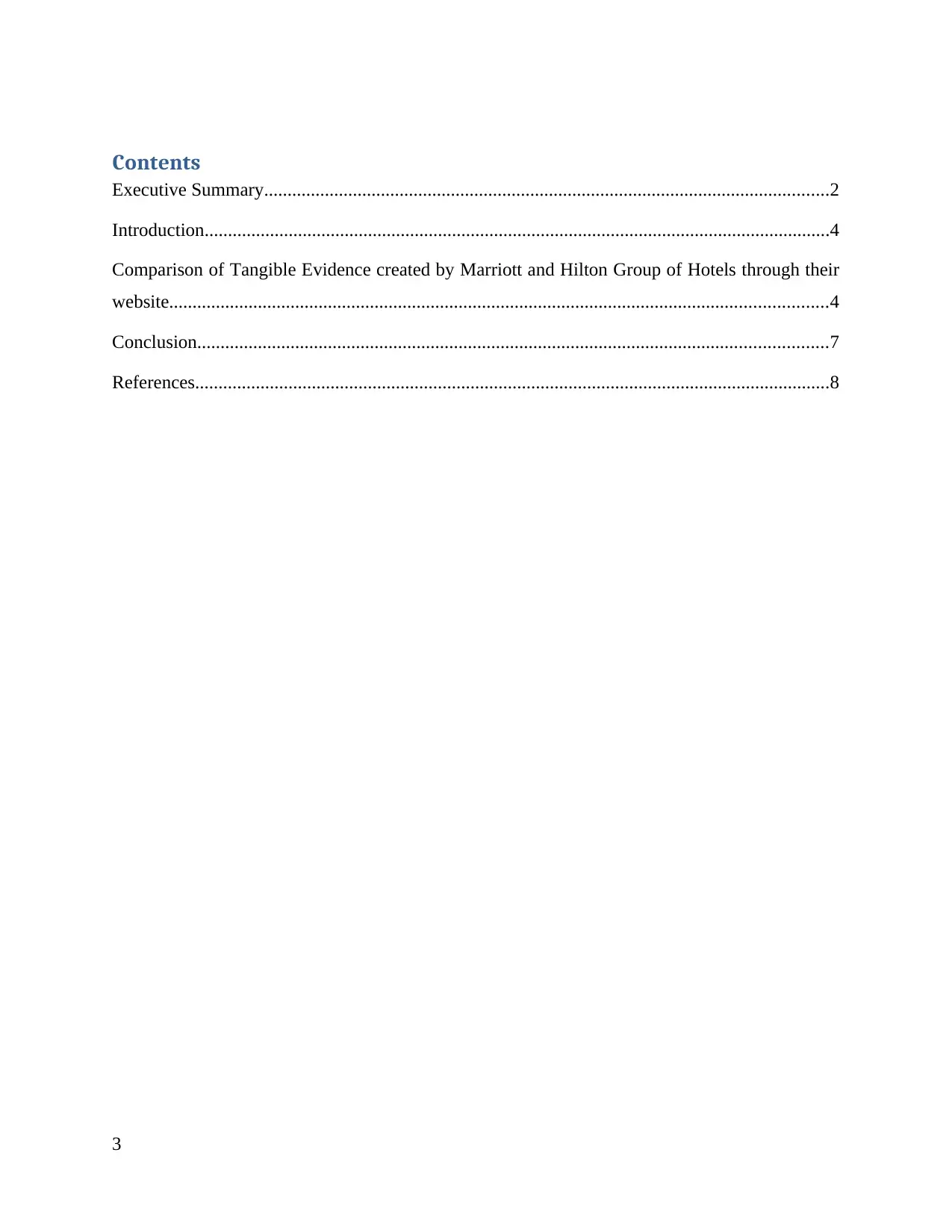
Contents
Executive Summary.........................................................................................................................2
Introduction......................................................................................................................................4
Comparison of Tangible Evidence created by Marriott and Hilton Group of Hotels through their
website.............................................................................................................................................4
Conclusion.......................................................................................................................................7
References........................................................................................................................................8
3
Executive Summary.........................................................................................................................2
Introduction......................................................................................................................................4
Comparison of Tangible Evidence created by Marriott and Hilton Group of Hotels through their
website.............................................................................................................................................4
Conclusion.......................................................................................................................................7
References........................................................................................................................................8
3
⊘ This is a preview!⊘
Do you want full access?
Subscribe today to unlock all pages.

Trusted by 1+ million students worldwide
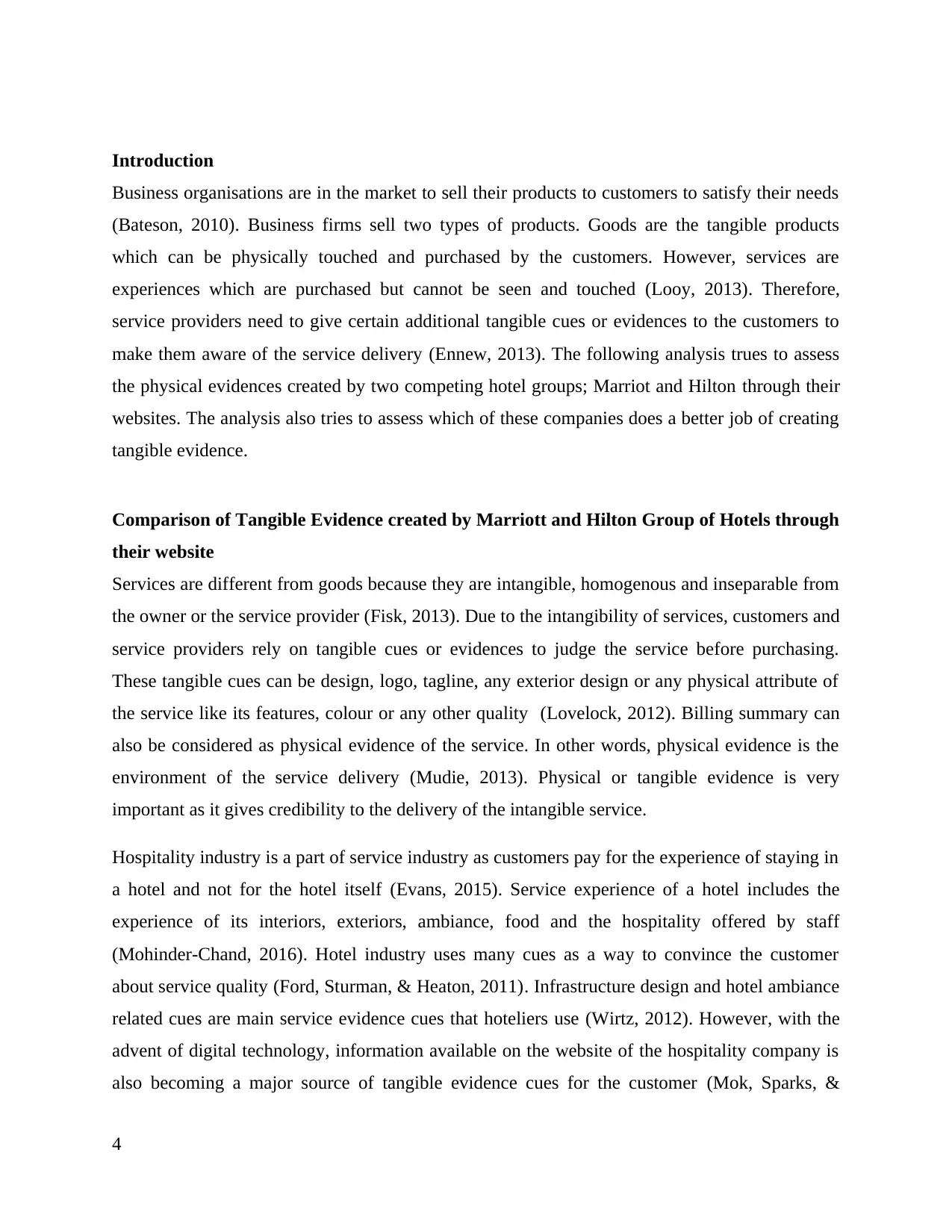
Introduction
Business organisations are in the market to sell their products to customers to satisfy their needs
(Bateson, 2010). Business firms sell two types of products. Goods are the tangible products
which can be physically touched and purchased by the customers. However, services are
experiences which are purchased but cannot be seen and touched (Looy, 2013). Therefore,
service providers need to give certain additional tangible cues or evidences to the customers to
make them aware of the service delivery (Ennew, 2013). The following analysis trues to assess
the physical evidences created by two competing hotel groups; Marriot and Hilton through their
websites. The analysis also tries to assess which of these companies does a better job of creating
tangible evidence.
Comparison of Tangible Evidence created by Marriott and Hilton Group of Hotels through
their website
Services are different from goods because they are intangible, homogenous and inseparable from
the owner or the service provider (Fisk, 2013). Due to the intangibility of services, customers and
service providers rely on tangible cues or evidences to judge the service before purchasing.
These tangible cues can be design, logo, tagline, any exterior design or any physical attribute of
the service like its features, colour or any other quality (Lovelock, 2012). Billing summary can
also be considered as physical evidence of the service. In other words, physical evidence is the
environment of the service delivery (Mudie, 2013). Physical or tangible evidence is very
important as it gives credibility to the delivery of the intangible service.
Hospitality industry is a part of service industry as customers pay for the experience of staying in
a hotel and not for the hotel itself (Evans, 2015). Service experience of a hotel includes the
experience of its interiors, exteriors, ambiance, food and the hospitality offered by staff
(Mohinder-Chand, 2016). Hotel industry uses many cues as a way to convince the customer
about service quality (Ford, Sturman, & Heaton, 2011). Infrastructure design and hotel ambiance
related cues are main service evidence cues that hoteliers use (Wirtz, 2012). However, with the
advent of digital technology, information available on the website of the hospitality company is
also becoming a major source of tangible evidence cues for the customer (Mok, Sparks, &
4
Business organisations are in the market to sell their products to customers to satisfy their needs
(Bateson, 2010). Business firms sell two types of products. Goods are the tangible products
which can be physically touched and purchased by the customers. However, services are
experiences which are purchased but cannot be seen and touched (Looy, 2013). Therefore,
service providers need to give certain additional tangible cues or evidences to the customers to
make them aware of the service delivery (Ennew, 2013). The following analysis trues to assess
the physical evidences created by two competing hotel groups; Marriot and Hilton through their
websites. The analysis also tries to assess which of these companies does a better job of creating
tangible evidence.
Comparison of Tangible Evidence created by Marriott and Hilton Group of Hotels through
their website
Services are different from goods because they are intangible, homogenous and inseparable from
the owner or the service provider (Fisk, 2013). Due to the intangibility of services, customers and
service providers rely on tangible cues or evidences to judge the service before purchasing.
These tangible cues can be design, logo, tagline, any exterior design or any physical attribute of
the service like its features, colour or any other quality (Lovelock, 2012). Billing summary can
also be considered as physical evidence of the service. In other words, physical evidence is the
environment of the service delivery (Mudie, 2013). Physical or tangible evidence is very
important as it gives credibility to the delivery of the intangible service.
Hospitality industry is a part of service industry as customers pay for the experience of staying in
a hotel and not for the hotel itself (Evans, 2015). Service experience of a hotel includes the
experience of its interiors, exteriors, ambiance, food and the hospitality offered by staff
(Mohinder-Chand, 2016). Hotel industry uses many cues as a way to convince the customer
about service quality (Ford, Sturman, & Heaton, 2011). Infrastructure design and hotel ambiance
related cues are main service evidence cues that hoteliers use (Wirtz, 2012). However, with the
advent of digital technology, information available on the website of the hospitality company is
also becoming a major source of tangible evidence cues for the customer (Mok, Sparks, &
4
Paraphrase This Document
Need a fresh take? Get an instant paraphrase of this document with our AI Paraphraser
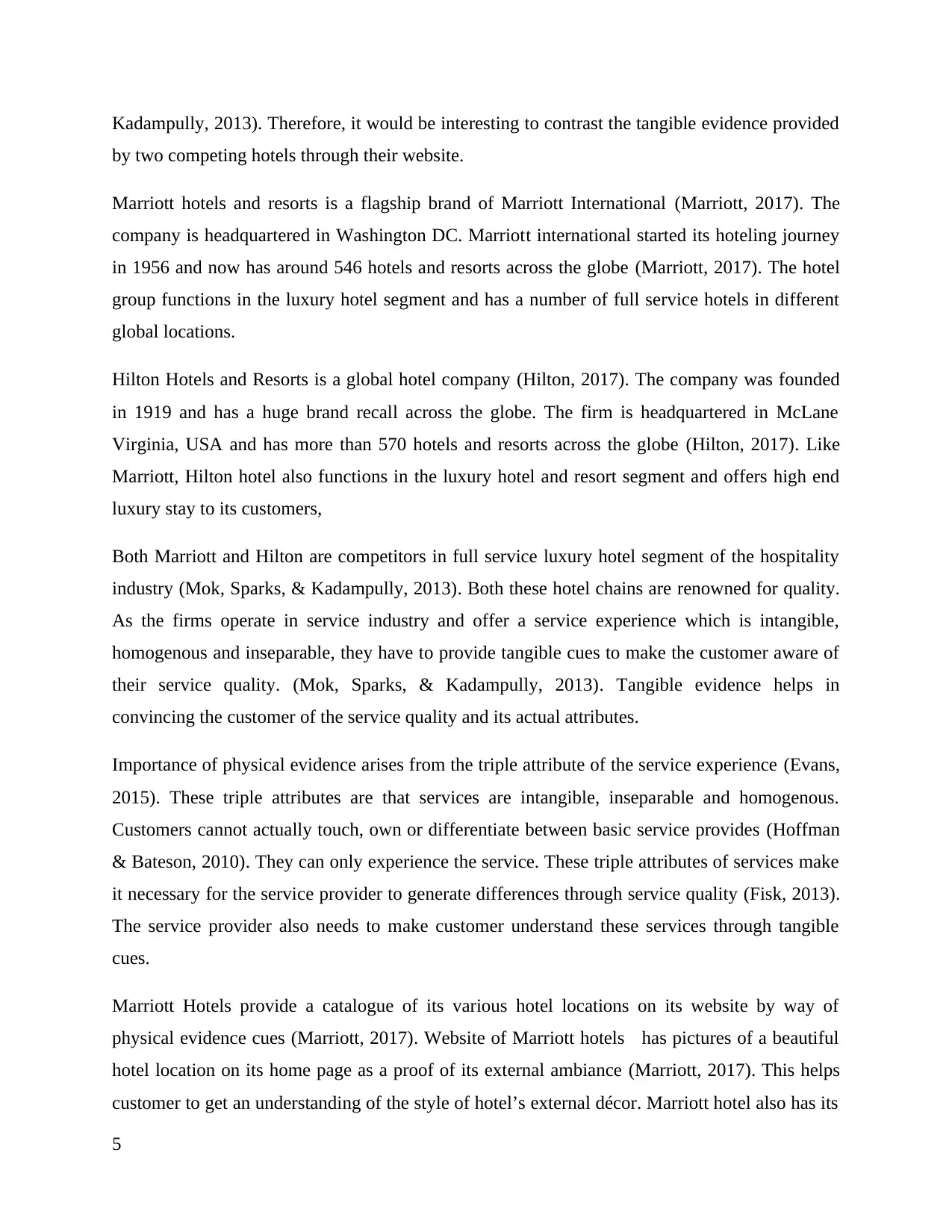
Kadampully, 2013). Therefore, it would be interesting to contrast the tangible evidence provided
by two competing hotels through their website.
Marriott hotels and resorts is a flagship brand of Marriott International (Marriott, 2017). The
company is headquartered in Washington DC. Marriott international started its hoteling journey
in 1956 and now has around 546 hotels and resorts across the globe (Marriott, 2017). The hotel
group functions in the luxury hotel segment and has a number of full service hotels in different
global locations.
Hilton Hotels and Resorts is a global hotel company (Hilton, 2017). The company was founded
in 1919 and has a huge brand recall across the globe. The firm is headquartered in McLane
Virginia, USA and has more than 570 hotels and resorts across the globe (Hilton, 2017). Like
Marriott, Hilton hotel also functions in the luxury hotel and resort segment and offers high end
luxury stay to its customers,
Both Marriott and Hilton are competitors in full service luxury hotel segment of the hospitality
industry (Mok, Sparks, & Kadampully, 2013). Both these hotel chains are renowned for quality.
As the firms operate in service industry and offer a service experience which is intangible,
homogenous and inseparable, they have to provide tangible cues to make the customer aware of
their service quality. (Mok, Sparks, & Kadampully, 2013). Tangible evidence helps in
convincing the customer of the service quality and its actual attributes.
Importance of physical evidence arises from the triple attribute of the service experience (Evans,
2015). These triple attributes are that services are intangible, inseparable and homogenous.
Customers cannot actually touch, own or differentiate between basic service provides (Hoffman
& Bateson, 2010). They can only experience the service. These triple attributes of services make
it necessary for the service provider to generate differences through service quality (Fisk, 2013).
The service provider also needs to make customer understand these services through tangible
cues.
Marriott Hotels provide a catalogue of its various hotel locations on its website by way of
physical evidence cues (Marriott, 2017). Website of Marriott hotels has pictures of a beautiful
hotel location on its home page as a proof of its external ambiance (Marriott, 2017). This helps
customer to get an understanding of the style of hotel’s external décor. Marriott hotel also has its
5
by two competing hotels through their website.
Marriott hotels and resorts is a flagship brand of Marriott International (Marriott, 2017). The
company is headquartered in Washington DC. Marriott international started its hoteling journey
in 1956 and now has around 546 hotels and resorts across the globe (Marriott, 2017). The hotel
group functions in the luxury hotel segment and has a number of full service hotels in different
global locations.
Hilton Hotels and Resorts is a global hotel company (Hilton, 2017). The company was founded
in 1919 and has a huge brand recall across the globe. The firm is headquartered in McLane
Virginia, USA and has more than 570 hotels and resorts across the globe (Hilton, 2017). Like
Marriott, Hilton hotel also functions in the luxury hotel and resort segment and offers high end
luxury stay to its customers,
Both Marriott and Hilton are competitors in full service luxury hotel segment of the hospitality
industry (Mok, Sparks, & Kadampully, 2013). Both these hotel chains are renowned for quality.
As the firms operate in service industry and offer a service experience which is intangible,
homogenous and inseparable, they have to provide tangible cues to make the customer aware of
their service quality. (Mok, Sparks, & Kadampully, 2013). Tangible evidence helps in
convincing the customer of the service quality and its actual attributes.
Importance of physical evidence arises from the triple attribute of the service experience (Evans,
2015). These triple attributes are that services are intangible, inseparable and homogenous.
Customers cannot actually touch, own or differentiate between basic service provides (Hoffman
& Bateson, 2010). They can only experience the service. These triple attributes of services make
it necessary for the service provider to generate differences through service quality (Fisk, 2013).
The service provider also needs to make customer understand these services through tangible
cues.
Marriott Hotels provide a catalogue of its various hotel locations on its website by way of
physical evidence cues (Marriott, 2017). Website of Marriott hotels has pictures of a beautiful
hotel location on its home page as a proof of its external ambiance (Marriott, 2017). This helps
customer to get an understanding of the style of hotel’s external décor. Marriott hotel also has its
5
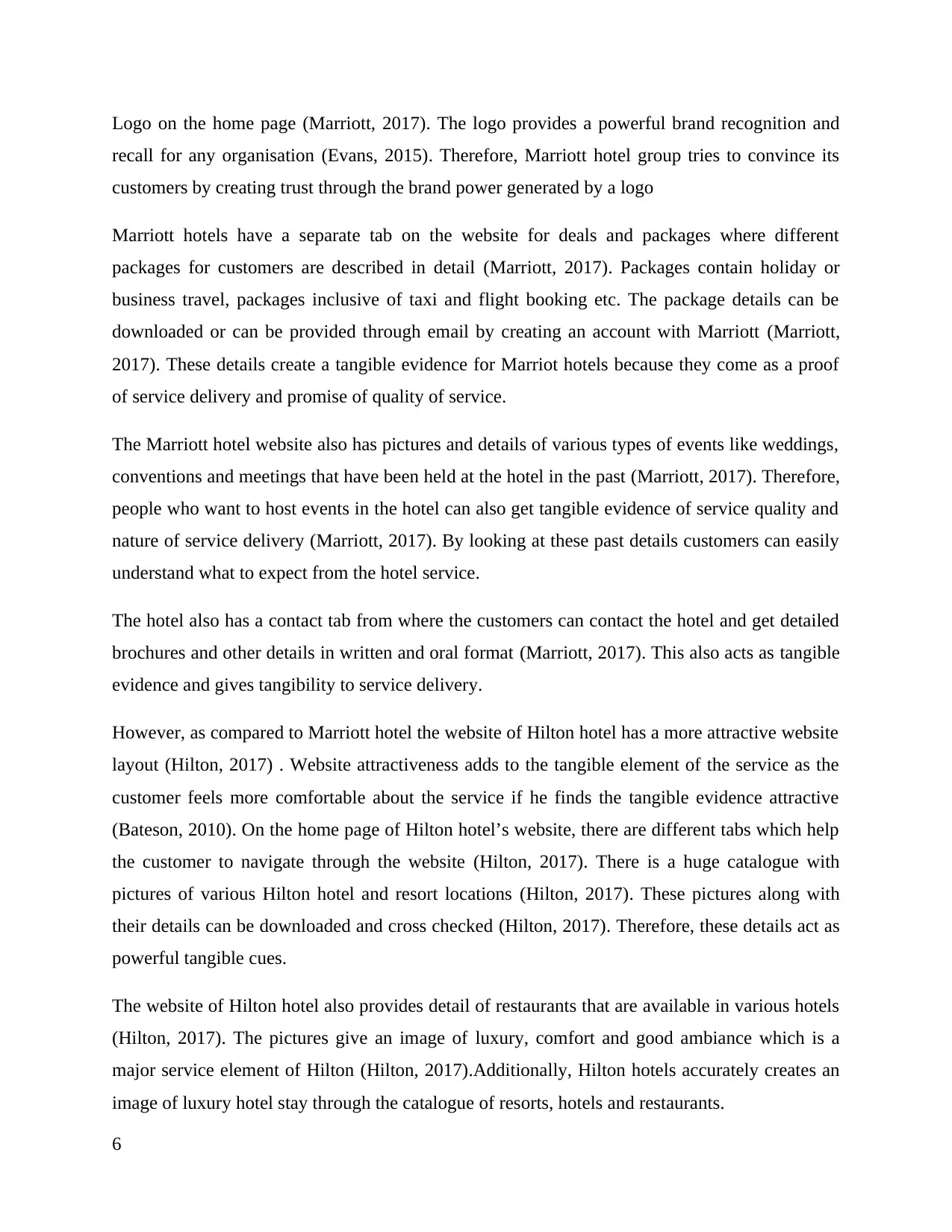
Logo on the home page (Marriott, 2017). The logo provides a powerful brand recognition and
recall for any organisation (Evans, 2015). Therefore, Marriott hotel group tries to convince its
customers by creating trust through the brand power generated by a logo
Marriott hotels have a separate tab on the website for deals and packages where different
packages for customers are described in detail (Marriott, 2017). Packages contain holiday or
business travel, packages inclusive of taxi and flight booking etc. The package details can be
downloaded or can be provided through email by creating an account with Marriott (Marriott,
2017). These details create a tangible evidence for Marriot hotels because they come as a proof
of service delivery and promise of quality of service.
The Marriott hotel website also has pictures and details of various types of events like weddings,
conventions and meetings that have been held at the hotel in the past (Marriott, 2017). Therefore,
people who want to host events in the hotel can also get tangible evidence of service quality and
nature of service delivery (Marriott, 2017). By looking at these past details customers can easily
understand what to expect from the hotel service.
The hotel also has a contact tab from where the customers can contact the hotel and get detailed
brochures and other details in written and oral format (Marriott, 2017). This also acts as tangible
evidence and gives tangibility to service delivery.
However, as compared to Marriott hotel the website of Hilton hotel has a more attractive website
layout (Hilton, 2017) . Website attractiveness adds to the tangible element of the service as the
customer feels more comfortable about the service if he finds the tangible evidence attractive
(Bateson, 2010). On the home page of Hilton hotel’s website, there are different tabs which help
the customer to navigate through the website (Hilton, 2017). There is a huge catalogue with
pictures of various Hilton hotel and resort locations (Hilton, 2017). These pictures along with
their details can be downloaded and cross checked (Hilton, 2017). Therefore, these details act as
powerful tangible cues.
The website of Hilton hotel also provides detail of restaurants that are available in various hotels
(Hilton, 2017). The pictures give an image of luxury, comfort and good ambiance which is a
major service element of Hilton (Hilton, 2017).Additionally, Hilton hotels accurately creates an
image of luxury hotel stay through the catalogue of resorts, hotels and restaurants.
6
recall for any organisation (Evans, 2015). Therefore, Marriott hotel group tries to convince its
customers by creating trust through the brand power generated by a logo
Marriott hotels have a separate tab on the website for deals and packages where different
packages for customers are described in detail (Marriott, 2017). Packages contain holiday or
business travel, packages inclusive of taxi and flight booking etc. The package details can be
downloaded or can be provided through email by creating an account with Marriott (Marriott,
2017). These details create a tangible evidence for Marriot hotels because they come as a proof
of service delivery and promise of quality of service.
The Marriott hotel website also has pictures and details of various types of events like weddings,
conventions and meetings that have been held at the hotel in the past (Marriott, 2017). Therefore,
people who want to host events in the hotel can also get tangible evidence of service quality and
nature of service delivery (Marriott, 2017). By looking at these past details customers can easily
understand what to expect from the hotel service.
The hotel also has a contact tab from where the customers can contact the hotel and get detailed
brochures and other details in written and oral format (Marriott, 2017). This also acts as tangible
evidence and gives tangibility to service delivery.
However, as compared to Marriott hotel the website of Hilton hotel has a more attractive website
layout (Hilton, 2017) . Website attractiveness adds to the tangible element of the service as the
customer feels more comfortable about the service if he finds the tangible evidence attractive
(Bateson, 2010). On the home page of Hilton hotel’s website, there are different tabs which help
the customer to navigate through the website (Hilton, 2017). There is a huge catalogue with
pictures of various Hilton hotel and resort locations (Hilton, 2017). These pictures along with
their details can be downloaded and cross checked (Hilton, 2017). Therefore, these details act as
powerful tangible cues.
The website of Hilton hotel also provides detail of restaurants that are available in various hotels
(Hilton, 2017). The pictures give an image of luxury, comfort and good ambiance which is a
major service element of Hilton (Hilton, 2017).Additionally, Hilton hotels accurately creates an
image of luxury hotel stay through the catalogue of resorts, hotels and restaurants.
6
⊘ This is a preview!⊘
Do you want full access?
Subscribe today to unlock all pages.

Trusted by 1+ million students worldwide
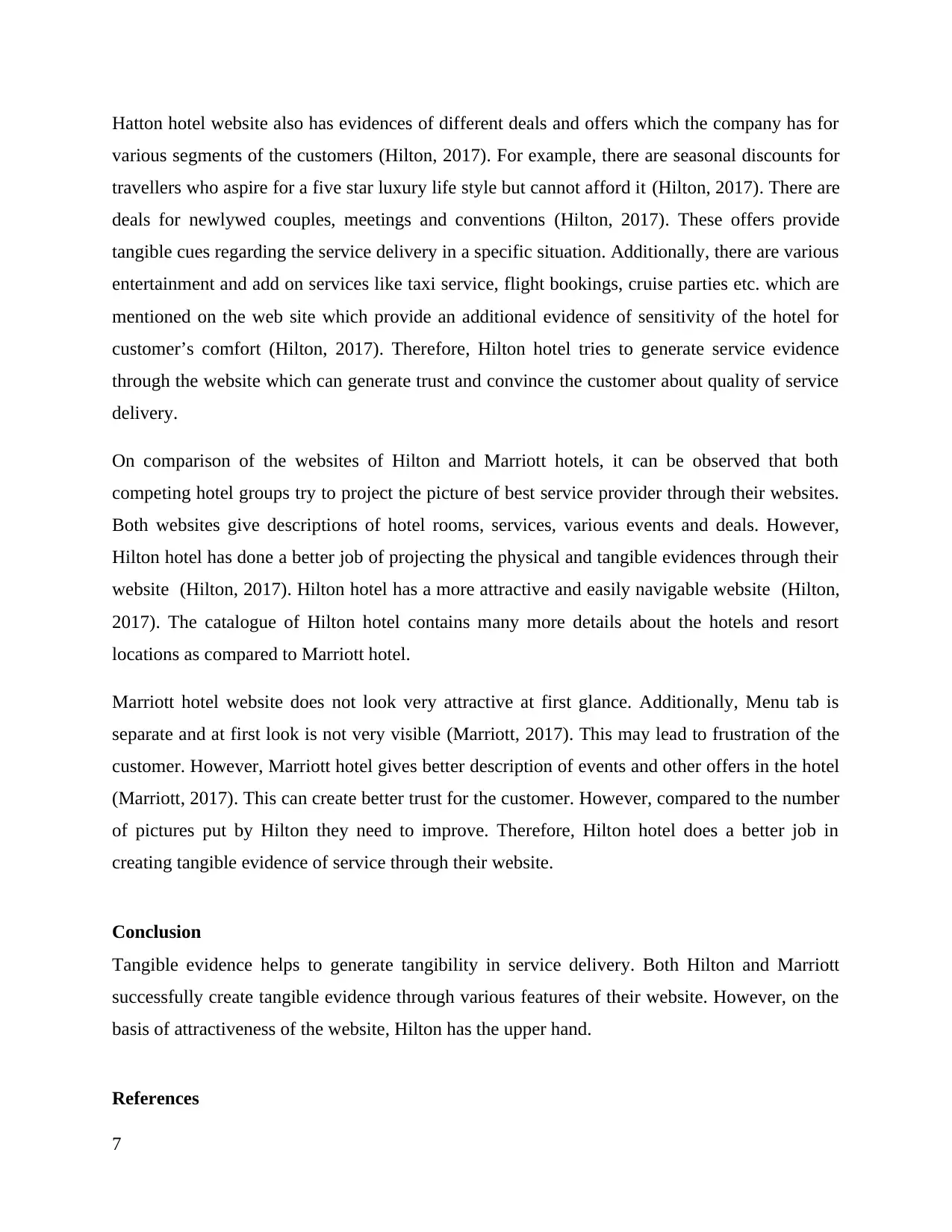
Hatton hotel website also has evidences of different deals and offers which the company has for
various segments of the customers (Hilton, 2017). For example, there are seasonal discounts for
travellers who aspire for a five star luxury life style but cannot afford it (Hilton, 2017). There are
deals for newlywed couples, meetings and conventions (Hilton, 2017). These offers provide
tangible cues regarding the service delivery in a specific situation. Additionally, there are various
entertainment and add on services like taxi service, flight bookings, cruise parties etc. which are
mentioned on the web site which provide an additional evidence of sensitivity of the hotel for
customer’s comfort (Hilton, 2017). Therefore, Hilton hotel tries to generate service evidence
through the website which can generate trust and convince the customer about quality of service
delivery.
On comparison of the websites of Hilton and Marriott hotels, it can be observed that both
competing hotel groups try to project the picture of best service provider through their websites.
Both websites give descriptions of hotel rooms, services, various events and deals. However,
Hilton hotel has done a better job of projecting the physical and tangible evidences through their
website (Hilton, 2017). Hilton hotel has a more attractive and easily navigable website (Hilton,
2017). The catalogue of Hilton hotel contains many more details about the hotels and resort
locations as compared to Marriott hotel.
Marriott hotel website does not look very attractive at first glance. Additionally, Menu tab is
separate and at first look is not very visible (Marriott, 2017). This may lead to frustration of the
customer. However, Marriott hotel gives better description of events and other offers in the hotel
(Marriott, 2017). This can create better trust for the customer. However, compared to the number
of pictures put by Hilton they need to improve. Therefore, Hilton hotel does a better job in
creating tangible evidence of service through their website.
Conclusion
Tangible evidence helps to generate tangibility in service delivery. Both Hilton and Marriott
successfully create tangible evidence through various features of their website. However, on the
basis of attractiveness of the website, Hilton has the upper hand.
References
7
various segments of the customers (Hilton, 2017). For example, there are seasonal discounts for
travellers who aspire for a five star luxury life style but cannot afford it (Hilton, 2017). There are
deals for newlywed couples, meetings and conventions (Hilton, 2017). These offers provide
tangible cues regarding the service delivery in a specific situation. Additionally, there are various
entertainment and add on services like taxi service, flight bookings, cruise parties etc. which are
mentioned on the web site which provide an additional evidence of sensitivity of the hotel for
customer’s comfort (Hilton, 2017). Therefore, Hilton hotel tries to generate service evidence
through the website which can generate trust and convince the customer about quality of service
delivery.
On comparison of the websites of Hilton and Marriott hotels, it can be observed that both
competing hotel groups try to project the picture of best service provider through their websites.
Both websites give descriptions of hotel rooms, services, various events and deals. However,
Hilton hotel has done a better job of projecting the physical and tangible evidences through their
website (Hilton, 2017). Hilton hotel has a more attractive and easily navigable website (Hilton,
2017). The catalogue of Hilton hotel contains many more details about the hotels and resort
locations as compared to Marriott hotel.
Marriott hotel website does not look very attractive at first glance. Additionally, Menu tab is
separate and at first look is not very visible (Marriott, 2017). This may lead to frustration of the
customer. However, Marriott hotel gives better description of events and other offers in the hotel
(Marriott, 2017). This can create better trust for the customer. However, compared to the number
of pictures put by Hilton they need to improve. Therefore, Hilton hotel does a better job in
creating tangible evidence of service through their website.
Conclusion
Tangible evidence helps to generate tangibility in service delivery. Both Hilton and Marriott
successfully create tangible evidence through various features of their website. However, on the
basis of attractiveness of the website, Hilton has the upper hand.
References
7
Paraphrase This Document
Need a fresh take? Get an instant paraphrase of this document with our AI Paraphraser
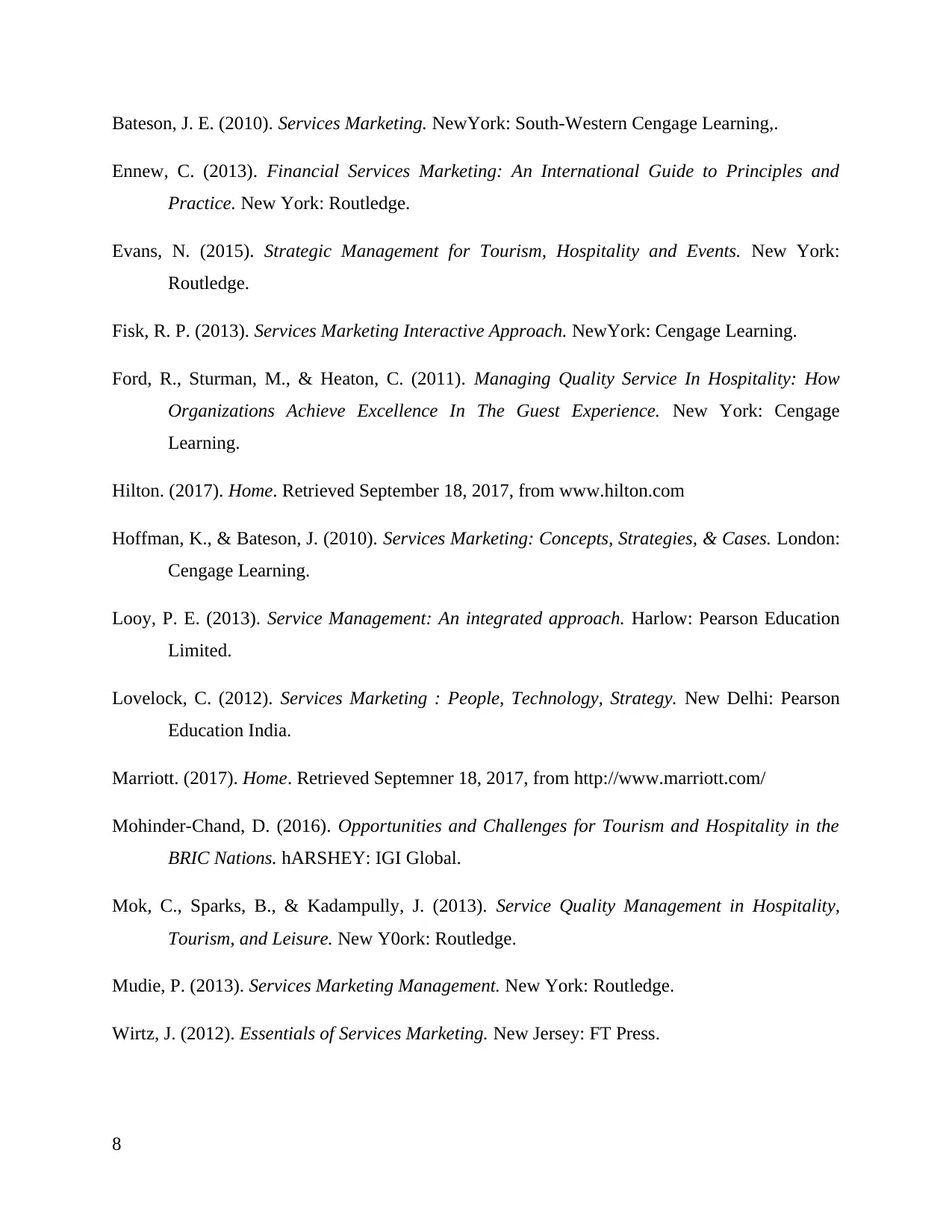
Bateson, J. E. (2010). Services Marketing. NewYork: South-Western Cengage Learning,.
Ennew, C. (2013). Financial Services Marketing: An International Guide to Principles and
Practice. New York: Routledge.
Evans, N. (2015). Strategic Management for Tourism, Hospitality and Events. New York:
Routledge.
Fisk, R. P. (2013). Services Marketing Interactive Approach. NewYork: Cengage Learning.
Ford, R., Sturman, M., & Heaton, C. (2011). Managing Quality Service In Hospitality: How
Organizations Achieve Excellence In The Guest Experience. New York: Cengage
Learning.
Hilton. (2017). Home. Retrieved September 18, 2017, from www.hilton.com
Hoffman, K., & Bateson, J. (2010). Services Marketing: Concepts, Strategies, & Cases. London:
Cengage Learning.
Looy, P. E. (2013). Service Management: An integrated approach. Harlow: Pearson Education
Limited.
Lovelock, C. (2012). Services Marketing : People, Technology, Strategy. New Delhi: Pearson
Education India.
Marriott. (2017). Home. Retrieved Septemner 18, 2017, from http://www.marriott.com/
Mohinder-Chand, D. (2016). Opportunities and Challenges for Tourism and Hospitality in the
BRIC Nations. hARSHEY: IGI Global.
Mok, C., Sparks, B., & Kadampully, J. (2013). Service Quality Management in Hospitality,
Tourism, and Leisure. New Y0ork: Routledge.
Mudie, P. (2013). Services Marketing Management. New York: Routledge.
Wirtz, J. (2012). Essentials of Services Marketing. New Jersey: FT Press.
8
Ennew, C. (2013). Financial Services Marketing: An International Guide to Principles and
Practice. New York: Routledge.
Evans, N. (2015). Strategic Management for Tourism, Hospitality and Events. New York:
Routledge.
Fisk, R. P. (2013). Services Marketing Interactive Approach. NewYork: Cengage Learning.
Ford, R., Sturman, M., & Heaton, C. (2011). Managing Quality Service In Hospitality: How
Organizations Achieve Excellence In The Guest Experience. New York: Cengage
Learning.
Hilton. (2017). Home. Retrieved September 18, 2017, from www.hilton.com
Hoffman, K., & Bateson, J. (2010). Services Marketing: Concepts, Strategies, & Cases. London:
Cengage Learning.
Looy, P. E. (2013). Service Management: An integrated approach. Harlow: Pearson Education
Limited.
Lovelock, C. (2012). Services Marketing : People, Technology, Strategy. New Delhi: Pearson
Education India.
Marriott. (2017). Home. Retrieved Septemner 18, 2017, from http://www.marriott.com/
Mohinder-Chand, D. (2016). Opportunities and Challenges for Tourism and Hospitality in the
BRIC Nations. hARSHEY: IGI Global.
Mok, C., Sparks, B., & Kadampully, J. (2013). Service Quality Management in Hospitality,
Tourism, and Leisure. New Y0ork: Routledge.
Mudie, P. (2013). Services Marketing Management. New York: Routledge.
Wirtz, J. (2012). Essentials of Services Marketing. New Jersey: FT Press.
8

9
⊘ This is a preview!⊘
Do you want full access?
Subscribe today to unlock all pages.

Trusted by 1+ million students worldwide
1 out of 9
Related Documents
Your All-in-One AI-Powered Toolkit for Academic Success.
+13062052269
info@desklib.com
Available 24*7 on WhatsApp / Email
![[object Object]](/_next/static/media/star-bottom.7253800d.svg)
Unlock your academic potential
Copyright © 2020–2025 A2Z Services. All Rights Reserved. Developed and managed by ZUCOL.





